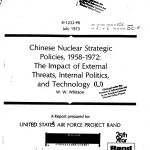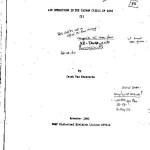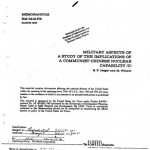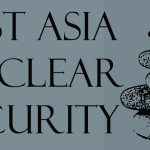John Delury, Assistant Professor of East Asian Studies at Yonsei University and Chung-in Moon, Professor of Political Science at Yonsei University state that a near-term crisis in North Korea is unlikely for the simple reason that the country’s political system is unified around the new face of North Korea, Kim Jong-un. However, in the medium to longer term, the new leadership is likely to face a dilemma: whether Kim Jong-un can enhance North Korea’s prosperity without undermining the source of its strength — its nuclear weapons program. Delury and Moon argue that “[t]he most prudent course for key regional players is to re-open or expand channels with Pyongyang. The better we know the new leadership, the better we can respond to events as they unfold.”
Author Archives: admin127
NAPSNet 19 January 2012
- DETERRENCE: Military aspects of a study of the implications of a communist Chinese nuclear capability
- DPRK: Kim Jong Un focuses on economic reforms, N. Korea official says
- CLIMATE CHANGE ADAPTATION: Catalyzing urban climate resilience: Applying resilience concepts to planning practice in the ACCCRN Program…
- ENERGY SECURITY: Simultaneously mitigating near-term climate change and improving human health and food security
- GOVERNANCE AND CIVIL SOCIETY: Washington, Beijing’s relief over Taiwan election will be temporary
Chinese Nuclear Strategic Policies, 1958-1972: The Impact of External Threats, International Politics, and Technology

This 1973 report by W.W. Whiston is the first of a two-part analysis of Chinese nuclear policy and weapons options carried out as a part of the U.S. Air Force Project RAND’s studies of the implications of Soviet and Chinese military policy and strategy for Air Force planning. It examines (1) internal political and ideological conflict, (2) alternative military strategies for coping with external versus internal threats, and (3) nuclear technological capabilities from 1958 to 1972. Whiston examines how the Mao-Liu divide impacted the military structure and organization and the newborn nuclear weapons program in the 1960s.
This report was released to the Nautilus Institute under the US Freedom of Information Act (FOIA). See the Institute’s FOIA Global Disclosure Project page to read more chronologies, histories and reports released to Nautilus.
Air Operations in the Taiwan Crisis of 1958

This report is one of a series of studies on air operations in international incidents, prepared by the USAF Historical Division Liaison Office at the request of the Directorate of Plans, Headquarters USAF. This historical narrative, by Jacob Van Staaveren, is based on primary source materials available in 1960–messages and correspondence–and on histories from many levels of the Air Force, including units, commands, and the Air Staff. As Staaveren’s report demonstrates, the crisis in 1958 provided a test of American military planning concepts. Occurring in the Pacific almost simultaneously with the Lebanon crisis of July-August 1958, it created certain planning, operational and logistical problems that had not been anticipated.
This report was released to the Nautilus Institute under the US Freedom of Information Act (FOIA). See the Institute’s FOIA Global Disclosure Project page to read more chronologies, histories and reports released to Nautilus.
NAPSNet 12 January 2012
- DETERRENCE: Deterring strategic cyberattack
- DPRK: DPRK blasts Lee Myung Bak’s new year address
- CLIMATE CHANGE ADAPTATION: Cities and climate change: Responding to an urgent agenda
- ENERGY SECURITY: Night fishing
- GOVERNANCE AND CIVIL SOCIETY: Tokyo and Seoul struggle to quit Iranian oil habit
Policy Forum 12-01: The DPRK Interregnum: Window of Opportunity for the International Community
Victor Hsu, a Visiting Professor at the Korea Development Institute School of Public Policy and Management, argues that the post funeral interregnum in the DPRK should be seen as a window of opportunity for moving North Korea’s relationships in a constructive direction. To do this, Hsu suggests that the international community network and create a coordinated engagement plan that avoids duplication, maximizes the increasingly scarce resources among traditional donors and gathers lessons learned for future engagement. Donors could facilitate this work by supporting civil society knowledge-sharing efforts with the DPRK, which is more sustainable and less susceptible to the vicissitudes of inter-state relations.
Military Aspects of a Study of the Implications of a Communist Chinese Nuclear Capability

In this 1963 report B.F. Jaeger and M. Weiner analyze Chinese nuclear capabilities under three different cross-strait conflict scenarios. The three scenarios provide an assessment of the possible military consequences of China’s possession of a modest nuclear arsenal, and give some indication of the magnitude of the risks China might face in a military confrontation with the United States over Taiwan.
This report was released to the Nautilus Institute under the US Freedom of Information Act (FOIA). See the Institute’s FOIA Global Disclosure Project page to read more chronologies, histories and reports released to Nautilus.
NAPSNet 05 January 2012
- DETERRENCE: A proposal for a nuclear weapons-free zone in northeast Asia
- DPRK: Joint New Year editorial
- CLIMATE CHANGE ADAPTATION: Climate uncertainties and their discontents: Increasing the impact of assessments on public understanding of…
- ENERGY SECURITY: Fukushima and the inevitability of accidents
- GOVERNANCE AND CIVIL SOCIETY: Opposition parties abundant in general election candidates
A Proposal for a Nuclear Weapons-Free Zone in Northeast Asia

Morton H. Halperin served four US presidents and is currently a Senior Adviser at the Open Society Foundation. Halperin notes that, as the Six-Party talks aimed at eliminating North Korea’s nuclear program remain stalled, a fresh approach incorporating the concept of a nuclear weapons-free zone in Northeast Asia should be considered as a way of ensuring peace and security in the region.
A version of this essay was originally presented at the East Asia Nuclear Security Workshop in Tokyo, Japan, on Nov. 11, 2011 convened by Nautilus Institute, Mansfield Foundation, and the Asia-Pacific Leadership Network. The workshop addressed the robustness of proposals to establish a nuclear weapons-free zone in the Northeast Asia region.
NAPSNet 29 December 2011
- DETERRENCE: Russia test-fires two new nuclear missiles
- DPRK: Nothing succeeds like succession: Chinese language perspectives on Kim Jong-Un’s transition to power
- CLIMATE CHANGE ADAPTATION: Local adaptation for livelihood resilience in Albay, Philippines
- ENERGY SECURITY: Japan’s nuclear village wages war on renewable energy and the feed-in tariff
- GOVERNANCE AND CIVIL SOCIETY: Japan, China focus on North Korea

